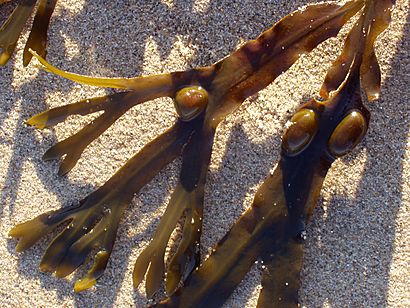Bladderwrack facts for kids
Quick facts for kids Bladderwrack |
|
|---|---|
 |
|
| Scientific classification | |
| Genus: |
Fucus
|
| Species: |
vesiculosus
|
Fucus vesiculosus, often called bladder wrack, is a common type of seaweed. You can find it growing along the coasts of the North Sea, the western Baltic Sea, and both the Atlantic and Pacific Oceans. Long ago, in 1811, bladder wrack was the first natural source where iodine was discovered. People used it a lot to help treat goitre, which is a swelling in the neck caused by a problem with the thyroid gland often due to not enough iodine.
Contents
What Bladder Wrack Looks Like
The leafy parts of bladder wrack, called fronds, can grow up to 90 centimeters (about 3 feet) long. They are usually about 2.5 centimeters (1 inch) wide. Each frond has a clear line down the middle, like a spine. The plant attaches itself to rocks using a disc-shaped "foot" called a holdfast.
One of the coolest things about bladder wrack is its small, round air bladders. These bladders are usually found in pairs, one on each side of the middle line. They help the seaweed float in the water. Younger plants might not have these bladders yet. The edges of the fronds are smooth, and the plant branches out in a way that looks like it's splitting in two repeatedly.
Where Bladder Wrack Lives
Bladder wrack is very common along the shores of the British Isles. It has been found on the Atlantic coasts of Europe, in Northern Russia, the Baltic Sea, Greenland, the Azores, Canary Islands, Morocco, and Madeira. You can also spot it on the Atlantic coast of North America, from Ellesmere Island and Hudson Bay all the way down to North Carolina.
Bladder Wrack's Role in Nature
This seaweed is especially common in calm areas of the shore, from the middle to lower parts of the intertidal zone. This is the area that is covered by water at high tide and exposed at low tide. On very rough, exposed shores, bladder wrack plants might be short and small, and they might not have their air bladders.
Bladder wrack provides a home and shelter for many small sea creatures. For example, tiny tube worms called Spirorbis spirorbis live on it. Other animals like plant-eating isopods (such as Idotea) and snails that graze on surfaces (like Littorina obtusata) also live among the fronds.
Bladder wrack also has special chemicals called Phlorotannins. These act like a natural defense, helping to protect the seaweed from snails like Littorina littorea that might try to eat it. Other chemicals, called galactolipids, help keep sea urchins away.
How Bladder Wrack Reproduces
Bladder wrack plants have separate male and female plants. This means they are dioecious. They release their reproductive cells, called Gametes, into the seawater, usually when the water is calm. The eggs are fertilized by the male cells soon after they are released.
A study done in Maine showed that almost all the eggs were fertilized, whether the seaweed was in a calm or exposed area. In the Baltic Sea, where bladder wrack is always underwater, the plants are very good at releasing their cells only when the water is calm. This helps make sure that most of the eggs get fertilized.
Bladder wrack from the North Sea moved into the Baltic Sea less than 8,000 years ago. In the Baltic Sea, these plants learned a new way to reproduce. Besides the usual sexual reproduction, they can also reproduce asexually. This means new plants can grow from broken pieces of the original plant. These pieces can float away and then reattach to the bottom by growing new "roots" called rhizoids. While other bladder wrack plants might have these extra branches, this special way of growing new plants from broken pieces has only been seen in the Baltic Sea.
Using Bladder Wrack
Bladder wrack is sometimes sold as a healthy food supplement. It contains many useful things like mucilage, algin, mannitol, and important minerals like iodine, bromine, and potassium. It also has beta-carotene.
Things to Know Before Using
If someone takes bladder wrack supplements, it can sometimes affect how their blood clots. This means it might make the effects of certain medicines, like warfarin, stronger. Because of this, it's a good idea to avoid taking bladder wrack before any surgery.
Also, some people might have an allergic reaction to the iodine found in bladder wrack. It's always best to talk to a doctor or a trusted adult before trying any new supplements.
See also
 In Spanish: Fucus vesiculosus para niños
In Spanish: Fucus vesiculosus para niños


